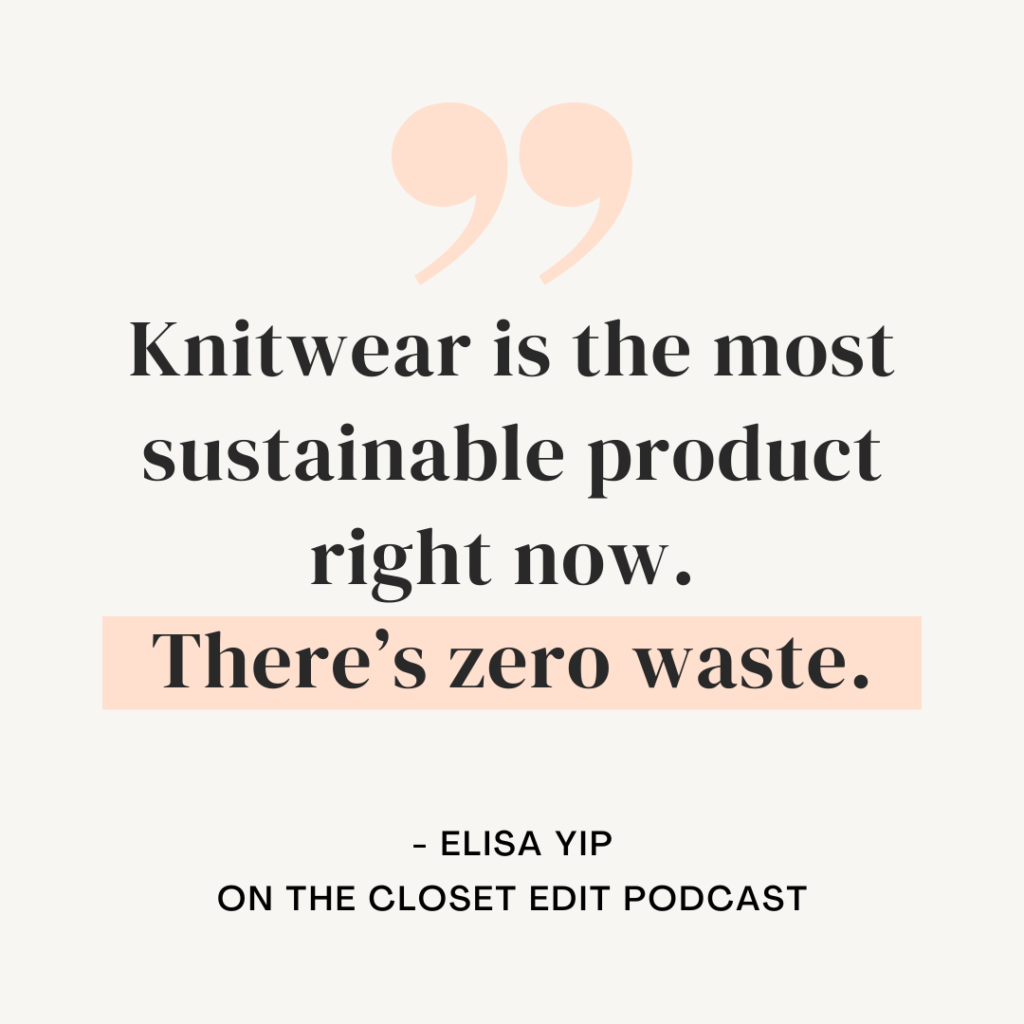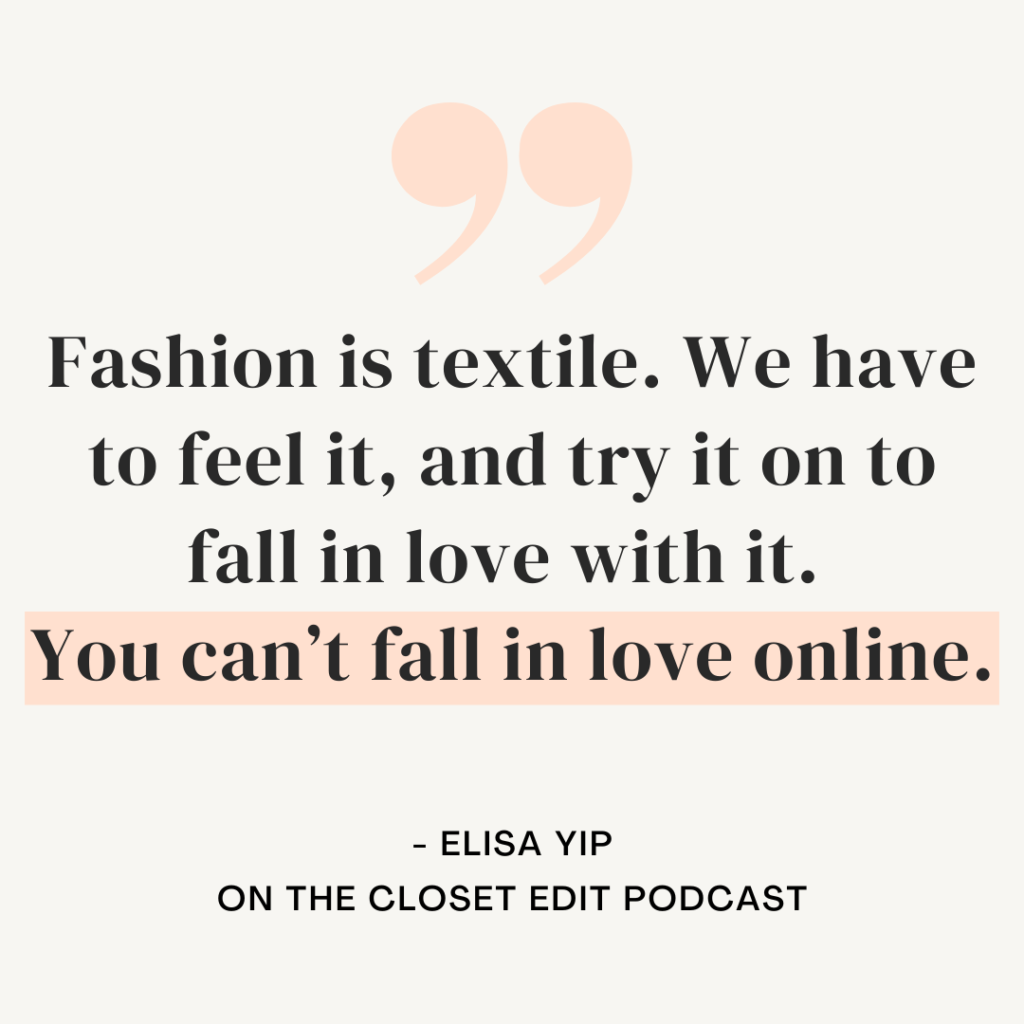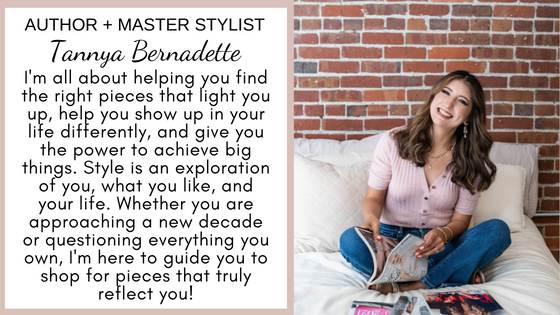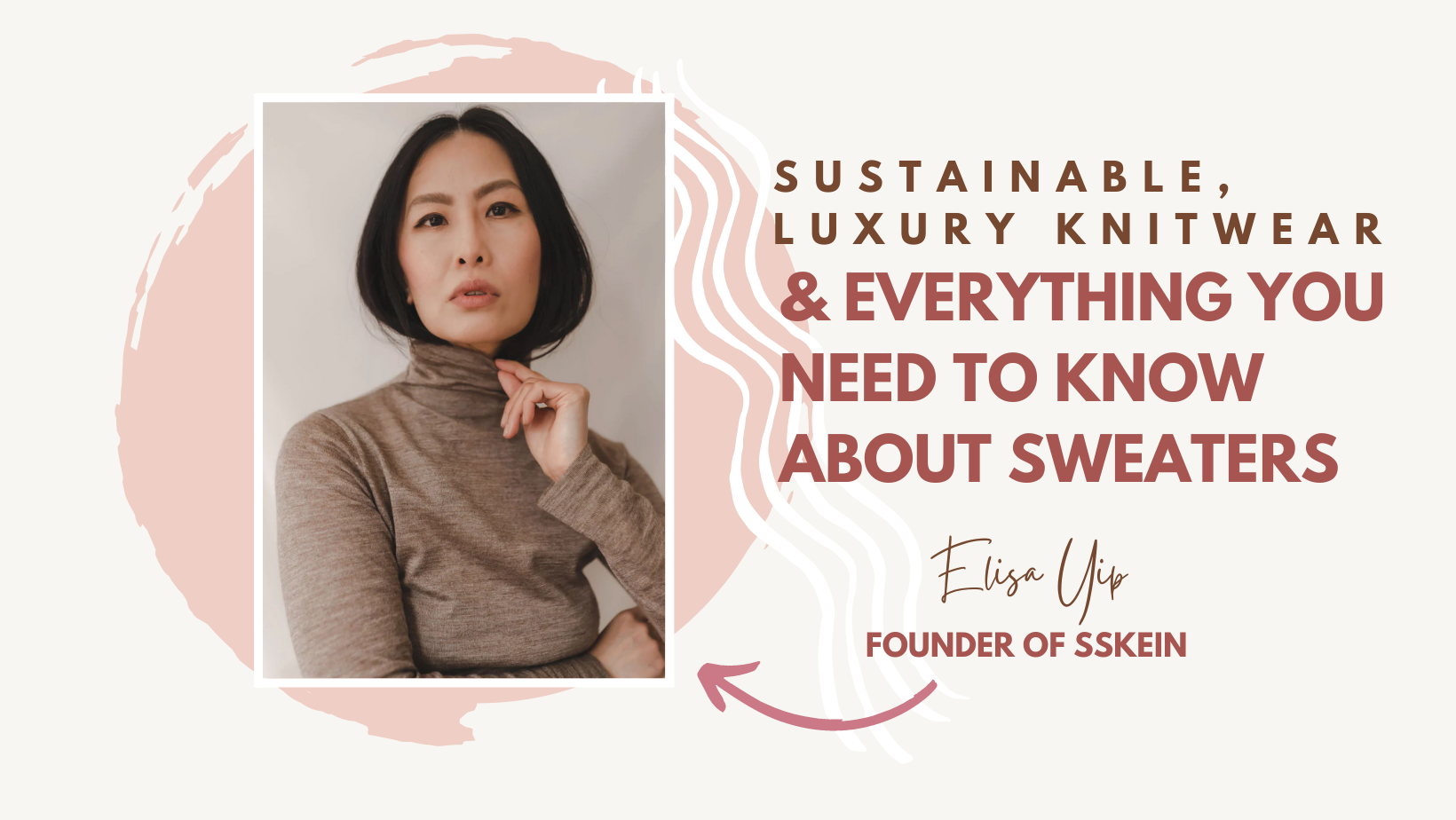It is full-on sweater season here in Seattle. It snowed a few weeks ago, and I don’t want to wear a blouse again until it starts warming up. Knitwear is abundant and available in many colors, neutrals, and styles. There are perfect options for work and casual wear. I wore a sweater every day last week, and I’m all for great trousers, pants, and warm sweater options right now.
As I work with clients through the shopping process, two questions have come up a lot: how do I invest in sustainable pieces, and how do I take care of my sweaters? I’ve researched and found the perfect passionate person who knows so much about this.
Elisa Yip is the founder of SSkein (pronounced as skān, which means a loosely coiled length of yarn or thread wound on a reel), a sustainable luxury knitwear brand made with purpose and integrity. We met at the Bellevue Collection Fashion show through one of my best friends, who has been trying to hook us up for years. When I went to her home to try on her pieces, I fell more in love with the brand because of how well-made it was. I don’t want to go into too much detail about her or Sskein because she shares everything you need to know about cashmere, alpaca, sweater care, how often to wash your sweaters, and so much more.
When you meet Elisa and touch her pieces, you cannot help but fall in love with her brand. Sskein is so much more than knitwear. It’s tied to a purpose, to elevate your basics, and she cares about you and what you’re wearing.
It’s empowering to learn about how your clothing is made, what goes into the process, and how you can make a difference with your purchases.
In this episode, you’ll learn:
- Everything you need to know about cashmere and alpaca
- How many wears can you get out of a sweater
- How often to wash your sweaters
- What kind of sweaters to hand wash vs. dry clean
- And so much more!
Turning Knitwear into a Sustainable Brand
Elisa started working in knitwear after finishing her degree at the Fashion Institute of Technology in New York City.
“My first job was as an assistant knitwear designer,” she recalled, “I learned from scratch, and I traveled a lot to learn about knitwear. You have to constantly educate yourself because there are so many changes in machinery and how people do things. After 23 years, I’m still learning.”
Elisa traveled and worked with the masters of knitwear. She traveled to Italy to look at yarn shows and went to China and met a lot of factory workers to see how everything came from a piece of string and knit into a complete fashion garment.
“Ever since I fell into knitwear, I’ve been so obsessed with it because you can create an entire garment from string to a 3D product, and that’s incredible,” she said.
After 20 years working as a Senior Designer at Nordstrom, she had to leave due to COVID. Like many during the pandemic, she thought, “What am I going to do with my life?”
“All I really knew was knitwear, so I created a brand that was sustainably sourced and eco-friendly,” Elisa remembered, “A brand that offered timeless, modern pieces for women who can make it their own. Use what they already have in the closet, and create a style for themselves.”
Sskein’s pieces are more timeless than trendy. They’re high-quality and made from sustainable materials.
“We wanted each piece to have a reason. We try to use 100% natural material where we can, so when we’re done with it, it breaks down on its own because it’s biodegradable,” Elisa said.

Many people don’t know that knitwear is one of the most sustainable products because there’s zero waste. You don’t have scrappy fabrics to throw in the landfill after you cut them because there’s nothing you can do with it.
“When you start with a string, you knit it into the shape of the pattern, then you link it from a different machine, and that’s your sweater. It’s been in existence forever,” Elisa explained.
Alpaca: A Sustainable Luxury Fiber
Elisa first heard about alpacas ten years ago and learned how sustainable they were as a luxury fiber. Alpacas are sustainable because of how the animals eat grass; their hooves are soft and don’t destroy grasslands.
“They usually eat less, so they’re not eating as much as other luxury animals, such as cashmere which comes from a goat,” Elisa explained.
Another reason alpacas are sustainable is because farmers shave alpacas once a year, and the hair turns into a product instead of thrown away.
Sskein’s yarn, mill, and factory are all in Peru, reducing the carbon footprint from the supply chain.
“We make sure when we work with farmers, they’re using sustainable shaving practices and not hurting the animals,” Elisa said.
In addition, alpaca is more efficient than cashmere. Alpaca is soft, silky, and much warmer than cashmere. It has a hollow fiber that traps heat and repels water. Alpaca sweaters shakes off water, but cashmere soaks up the rain.
The Pilling Process and How To Take Care of Sweaters So They Last Longer
All sweaters pill, especially synthetic, polyester, rayon fabrics, and anything else that has very loose knit or fibers, will also pill. The reason why cashmere sweaters are soft in America is because they wash them in factories. In Italy, cashmere is drier because they don’t. The more you wear it, the softer it gets. In America, the more you wear cashmere, the faster it pills.
The other reason it pills faster is that the longer the hair, the silkier. When you take those fibers, line them up, and twist them into a yarn, the shorter fibers will pill faster, which are the cheaper cashmere sweaters. The Italian cashmere sweaters have longer fibers; when they twist, they don’t have prickly little hairs. As you wear the sweater, the shorter fiber pills.

When searching for a high-quality sweater, look for a heavier sweater. The looser its knit (lighter the fabric), the less expensive it is to make. That’s why there are $95 cashmere and $2,000 cashmere sweaters.
“Do your research and invest in pieces that you know will last long,” Elsa said.
But how can you tell if it will last longer if you don’t have a stylist?
“First, if the sweater is under $200, put it back,” Elisa explained.
Second, put your hand behind the fabric. It’ll either snag or pill if you can see your hand, especially in an ivory color.
“I’m not saying to buy a $400 sweater, but if you can buy a $200 – $300 sweater, you’re most likely ok,” she said.
As mentioned, all sweaters will pill. You take care of it if you have a pill machine (you can get a handheld one on Amazon for around $25). Graze over it (don’t press hard because it’ll put a hole in your sweater) and take out those extra little balls every few times you wear it.
“If it’s a natural material like most of our products, it’s 100%; the moisture breaks off itself. So let it air out, fold it back nicely, and put it away. If you have moth issues, get those cedar blocks,” she said.
How many wears can you get of a sweater when it’s a natural fiber?
Elisa says it depends on your body chemistry and how often you wear it.
For example, if you sweat a lot, she recommends wearing a tank top underneath your sweater to absorb your body moisture, then you wouldn’t have to clean the sweater as much.
“Between each season, dry clean it a couple of times before you pack it away,” she said.
If your sweater is a natural material, you can wash it depending on how thick it is. For example, if it’s a reversible coat that’s too thick to hand wash, dry clean it. However, if the material is thin, you can hand wash it.
“Invest in pieces you love and can wear for a long time, is high-quality, and if you take care of them, they’ll last for a long time. I can’t say it’ll last forever; nothing is bulletproof. You have to spend some time and care for nice things,” Elisa explained.
Sskein’s On-Demand Knitwear and the Future of the Brand
Sskein’s on-demand service is different from Amazon or any fast-fashion company. When you place an order for an on-demand Sskein product, we knit the piece at a factory in Brooklyn for a week. Then we send it to you after a week of shipping.
“So you get a garment pretty much made for you in two weeks,” Elisa explained. “Versus having an excess inventory where it sits in a warehouse, it doesn’t get sold because sometimes you overestimate how you buy, then you mark things down and push things out.”
This way of shopping is different, but waiting for a piece to come to your door that you hand-selected is so much more special.
“It’s worth the wait, and it’s exciting,” Elisa said.
The future of Sskein is bright and ambitious. Elisa looks forward to expanding Sskein to a broader audience by opening doors to boutiques, adding more categories, and opening a storefront with a studio above it so she can work and help customers simultaneously.
“I love helping customers with styling and sharing our story with them,” she said.
Elisa has a couple of recommendations if you need help deciding which beautiful piece to buy from Sskein.
“We’re known for our jumpsuit,” she recommends. “The jumpsuit was part of our first capsule when we started our brand. It’s still around because it’s timeless and chic; you can dress it up or down. Super comfortable because it’s alpaca on the outside and cotton on the inside for comfort.”
The second recommendation she has is the Crew Neck Boxy Pullover. It’s available in different colors, warm, and high-quality. You’ll keep returning to it when you want something cozy to wear.
More from Elisa Yip:
Follow Elisa on Instagram @elisa_yip, and shop beautiful, sustainable pieces online at Sskein. Online shopping and photos can’t even portray the feel and look of every piece, but I encourage you to check them out.
Thank you for being here with me today. Keep on building a life and style that truly reflect you.
Looking for more styling tips? Be sure to follow me on Instagram @thecloset.edit and TikTok @theclosetedit!



[…] “Only wash your sweaters a few times a season.” You can listen to the full episode called, Sustainable, Luxury Knitwear and Everything You Need to Know. She shares how natural fibers have wicking properties, especially alpacas. Their coats are meant […]